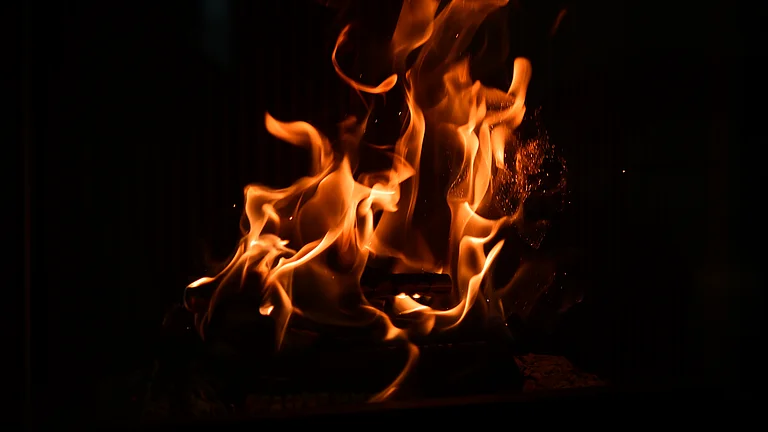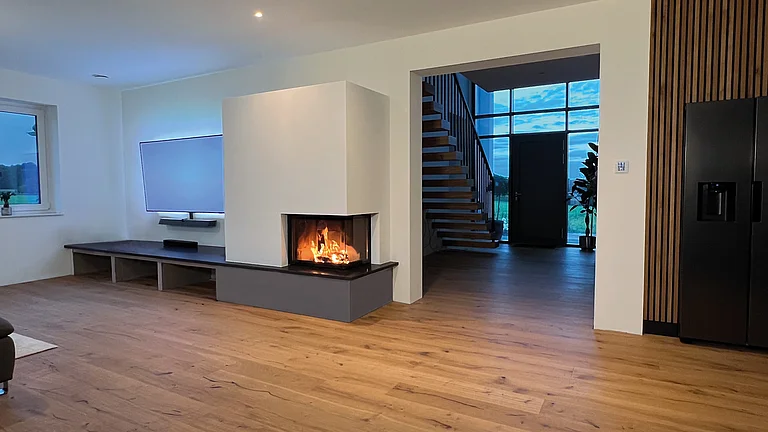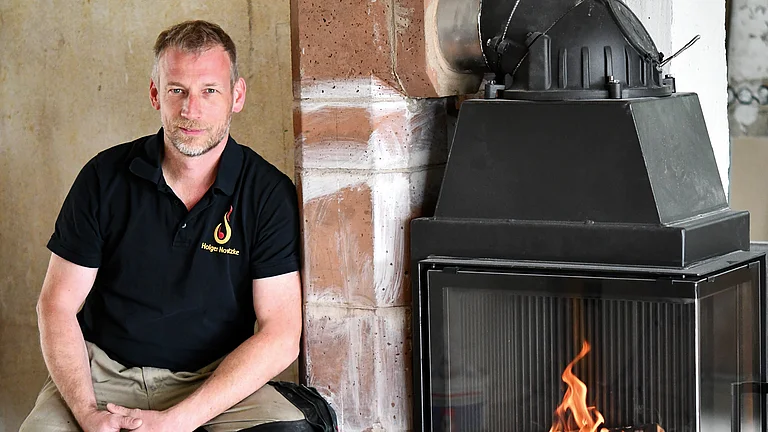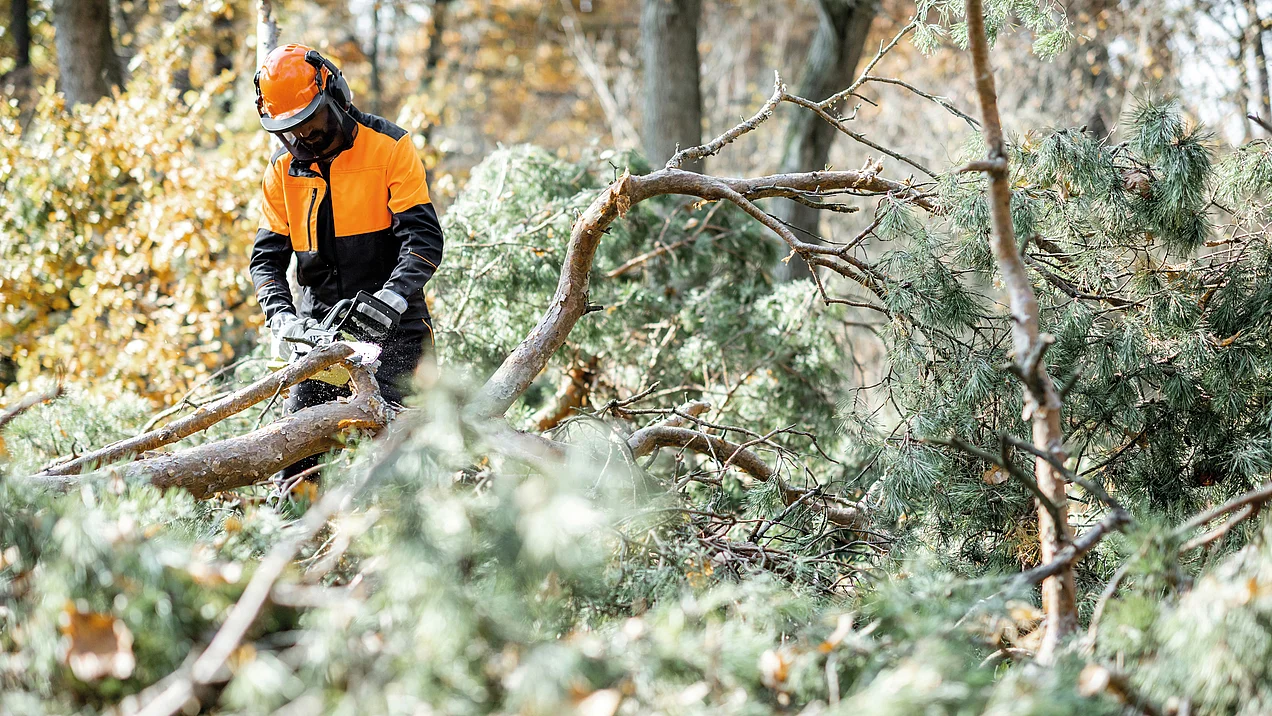
New forests for the country
Wood is a must-have
Even if climate change is altering our forests: Wood remains a valuable, renewable raw material with great potential for the energy transition. Prof. Dr. Bastian Kaiser from the Rottenburg University of Applied Forest Sciences explains the conditions under which the use of firewood makes ecological sense, why regional resources remain important and what the forest of tomorrow could look like.
There is a lot of discussion in society about the use of wood for energy. How important is wood from sustainable forestry for contributing to the energy transition?
Bastian Kaiser: The energy transition has several pillars: 1. supplying our society and the economy with electricity as the central process energy. 2. the transport transition and 3. the heating transition. For a very long time, the focus of environmental and energy policy was on securing the electricity supply and on the transport transition, which involved, for example, promoting electric cars, improving the charging infrastructure and electrifying public transport. The focus of these considerations was primarily on photovoltaics and wind power - and thus also the inevitable problems of an adequate grid infrastructure. The heating transition took place virtually in a quiet chamber and was at best a topic for experts. It wasn't until Putin's war of aggression against Ukraine, which violated international law, that people realized that the heat supply also had to be put on a different footing. Oil from Arab despots or Latin American autocrats, coal, coal dust and gas from Russia, energy transports via increasingly dangerous and unreliable transport routes, dangerous and endangered supply chains, technically risky treatment and conversion processes for energy supply and politically unacceptable dependencies on energy-exporting countries also (finally!) drew the attention of politicians and society to the heating sector. The fear of a cold winter and an inadequate national gas reserve was very real, widespread and not unfounded.
Only now did many people realize that domestic wood - a technically controllable, risk-free and politically unobjectionable, permanently renewable, domestic energy source in the heating market - was already making more than 50 percent of the contribution of renewable energies - that the experts had done a great job in their quiet chambers, making wood firing more modern, lower in emissions, more efficient, stoves ever more aesthetic and combustion systems ever more economical. Without the wood from our domestic and proven sustainable forestry, it would have been colder in our living rooms in the winter of 2022/2023, we would not be able to compensate for the economically, technically, politically and ethically correct renunciation of dubious imports of fossil fuels and the energy transition as a whole would not succeed.
In your opinion, is it justifiable to use wood to generate heat? And if so, under what conditions is it realistic to operate fireplaces with wood from German forests in the long term?
BK: Yes, it is justifiable! The clarity and distinctness of this statement has to do with the risks of other energy sources, their conversion, transportation and use, which I just mentioned and which we have all accepted uncritically for decades. Presumably because we have coal in post-war Germany and oil since the 1960s to thank for a large part of our prosperity and because this energy was cheap. Today we have long known that it was too cheap because the risks were not priced in.
In addition, fossil fuels are not renewable. Wood is renewable. It grows virtually behind our houses and is an energy source with very short distances and no political or technical risks. However, this is only fully true if we use wood from sustainably managed forests and do not import it from countries whose forest management we cannot control.
The primary aim of using domestic wood is and remains its material use - i.e. the long-term sequestration of carbon in wooden buildings, wooden structures (e.g. bridges) and in objects made of wood. From colored pencils and shovel styles to pianos and double basses.
However, we cannot and do not want to grow tree species that only consist of a trunk. Trees will always have parts that are not suitable for sawing or - in the case of damaged wood - are no longer suitable for sawing or are not of the quality required for meaningful material use. These parts are inevitable with every timber harvest. Doing without timber harvesting would mean leaving the forests to the natural course of earthly life. Every tree would then die at some point. As our forests are not primeval forests, but cultivated forests with a tradition of management spanning several centuries, many trees in a forest area are roughly the same age and die at roughly the same time. If we consider a forest as a CO2 reservoir, then after "full" comes "dead" at some point. As we cannot stop wood production in the forest, this will always remain the case, although forest conversion towards a higher proportion of hardwood will reduce growth.
Where do you see the limits of sustainable wood use and what role does energy recovery play compared to material use, for example as a building material?
BK: I am firmly convinced that we must use the potential of our forests to slow down the dynamics of climate change without neglecting other alternatives such as rewetting moors. However, in order to make the best possible use of this potential - also as part of our responsibility to future generations - we need to remove wood from the forest carbon store from time to time to make room for additional CO2, which the forests filter out of the atmosphere. Once the reservoir is full to the brim, it no longer provides us with any additional help, at best it remains at its "maximum carbon level" and in the worst case, namely the simultaneous death of many trees, it can even become a risk - a net emitter of CO2. We can therefore only increase the braking effect of forests on climate change if we process as much wood as possible into products that can be used in the long term, thus creating external storage and replacing other, significantly more energy-intensive, riskier and more climate-damaging building materials. If we also use non-sawable wood assortments and wood grown specifically for this purpose for energy purposes, we further reinforce this positive effect.
However, if we are pursuing a goal in a specific forest area, in a specific forest stand in a specific location, which we - or rather, which the forest owner - consider to be more important than combating climate change, then this goal has priority here. This can be, for example, the recreational function near the city, the protection of a certain animal or plant species or the protection of our groundwater, erosion protection in the mountains, noise protection or other things.
In my opinion, the use of wood for energy is much more than a kind of appendage or residual utilization of material use. In addition to its aforementioned geopolitical importance, its technical controllability and the transport advantages over other energy sources - even compared to wind energy, just think of the debates surrounding and the costs of the Südlink power lines - it complements material use in terms of its substitution effect, helps to cover timber harvesting costs and thus supports forest owners in their task of preserving the forest and making it fit for the future.
How important is sustainable forestry for Germany? If energy use were to be discontinued, only material use would remain. Would that be enough or would it mean the loss of a major source of income?
BK: The first part of this two-part question could be answered quite simply: forestry that continues to be sustainable and future-oriented is very important for Germany. If we no longer had it, we would be delegating the responsibility for securing and expanding the global CO2 reservoirs in the forests and in wood products, as well as the additional benefit of substituting other, climate-damaging building materials and energy sources, to other countries and shirking our responsibility by importing wood. Domestic sustainable forestry is therefore very important for all of us for the reasons already mentioned.
However, the second sub-question limits this fundamental and global significance too much. It focuses exclusively on monetary values, on turnover and income. In other words, it focuses exclusively on economic values based on prices and thus the successful sale of goods and services from the forest. This importance of forests has steadily declined in recent decades. For example, there are hardly any local authorities that are really dependent on the income from their communal forests. The situation is different for some private forest owners and for the innovative, efficient and modern timber industry in Germany. However, this is not because of the income, but because of the qualitatively reliable and quantitatively dependable supply of suitable timber for production. For forest owners and the timber industry, the income from the thermal utilization of the so-called residual wood assortments is a welcome, but for most of them not "vital additional income".
However, the preservation and strengthening of domestic forestry is not only about the income function of forests, but also about securing numerous other additional values and services that are of great importance to us all, but for whose consumption and use we generally do not have to pay anything. They have no price. In some cases, the preservation of such protective services and the recreational function of the forest is supported by the state. From the point of view of forest owners, however, they have to be paid for predominantly out of the income from the utilization function of their forest. In view of the costly and urgent forest conversion, every euro counts - including and especially every euro that can be earned for energy wood assortments under the conditions of responsible and sustainable forestry.
What contribution can the stove industry make to protect the forest and at the same time use it responsibly as a resource?
BK: Although forests as CO2 sinks, unlike moors and the world's oceans, can be increased and expanded by us humans and the wood constantly grows back, the multi-talented wood is and remains a scarce resource. It is both a victim of climate change and one of our potential "saviors". In order not to overburden the forests, we in our prosperous, technologically advanced economy must take great care to use this scarce resource responsibly.
The stove industry must therefore not let up in its efforts to make the thermal use of wood as efficient and low-emission as possible. The "feel-good fire in an open fireplace that can be controlled steplessly via the balcony door" is therefore rightly a thing of the past. The industry has long been aware of this and offers state-of-the-art heating systems that are not outdated, but rather an innovative and safe part of our heating transition.
I would therefore like to see the industry present itself and advertise in a more modern and proactive way. Images that appeal to the campfire romanticism of customers must finally disappear from advertising. On the other hand, the fact that burning wood is not emission-free, but that these emissions from well-managed, modern systems are no higher than those from modern gas heating systems, could certainly be dealt with more proactively.
And unlike fossil alternatives, burning wood is climate-neutral. It does make a difference to our efforts to curb climate change whether we release greenhouse gases when burning fossil fuels (oil, coal, gas) that have been removed from the atmosphere for millions of years or whether we are talking about CO2 that was "only recently" still gas, only bound as wood for a comparatively short time and removed from the atmosphere. In addition, the gas released when burning wood to generate heat and/or energy can never be more than what would also be released above ground during natural decay processes. In this case, however, without having previously derived any energy benefit from the wood.
If we also realize that, in view of the pressing time and the dynamics of climate change, we are currently even forced to bury the CO2 that we have extracted with oil, gas or coal from its deep, ancient earth reservoirs a few hundred kilometers away, at great financial and energetic expense, back into deep layers of the earth (CCS technology), then the absurdity of fossil fuels, their emissions and the advantages of the thermal use of wood become even clearer to us.
How would the forest have to develop over the next ten years in order to meet the challenges of climate change and ensure a sustainable supply of wood?
BK: The good news first: there will be forests in our latitudes for a very long time to come. Despite climate change. However, these forests will be different from our forests today and different tree species will grow in them. If we were to leave our forests, which we have managed and used for over 300 years, to their own devices and hope that they will adapt to the future climate, then we would be accepting large-scale disasters for many decades, including the temporary complete death of our forests. Our "cultivated forests" will not simply become natural or even primeval forests. The dynamics of climate change are now much greater than the self-adaptive forces of "nature" can react to.
Time is of the essence. And, as I have already said, the use of wood is not just about using a beautiful, modern and renewable raw material and using a politically and technically risk-free energy source, but also about removing as much CO2 as possible from the atmosphere, binding it in the forest (forest storage) and in wood products (external storage) in the long term and replacing as many climate-damaging building materials, materials and energy sources as possible (substitution). So this is not a "nice to have", but a "must have"!
Because the next 20 to 30 years will be crucial, we must continue to actively restructure the forests, spread the risk across many tree species, rely more on deciduous trees than on conifers and still ensure that our forests continue to produce wood that can be used for materials and energy in the future.
Perhaps this is why we can no longer cling to the claim that every hectare of forest can do almost everything: Produce wood, create recreational areas and develop numerous protective effects. That may be the case. Then we should consider and try to finance forest conversion towards a higher proportion of climate-resilient deciduous tree species as well as the protective and recreational services on as large an area as possible by using tree species that are easy to saw, with comparatively rapid growth on smaller areas, and thus at the same time further accelerate the expansion of the external CO2 reservoirs of forests and their substitution effect.
We would like to thank Prof. Dr. Dr. h.c. Bastian Kaiser for the in-depth interview. The statements make it clear: wood is not a romantic relic. It is a central building block for a sustainable heat supply. Provided that it is used responsibly and in balance with ecological reality. The stove industry is just as much in demand here as politics and forestry.
Prof. Dr. Dr. h.c. Bastian Kaiser
Rottenburg University of Applied Forest Sciences
Professorship of Applied Business Administration,
International Development Cooperation
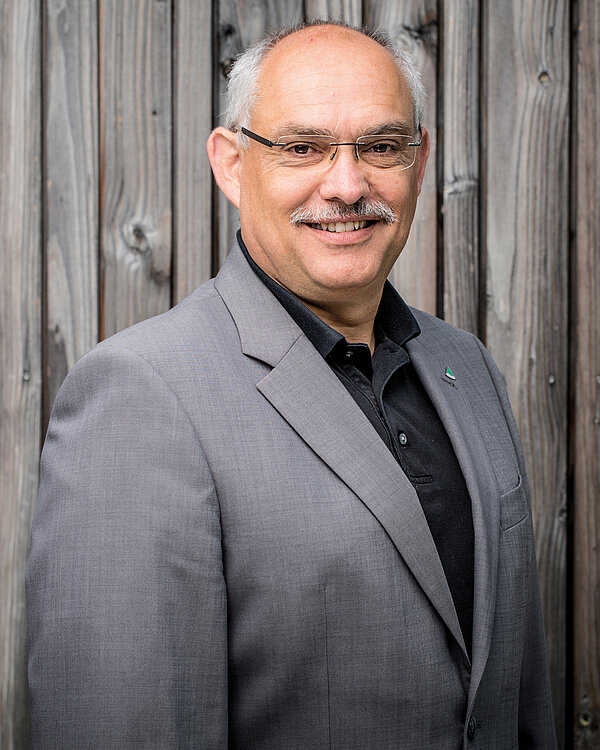
I'm in the forest!

In 2022, Bastian Kaiser published his book "Bin im Wald!" with Hirzel-Verlag Stuttgart. In it, he attempts to "tell the story" of the forest, forest management and its connections with climate, nature and species protection, the timber industry and our culture in such a way that a broad readership can be entertained and informed at the same time. The first two editions were sold out within a calendar year. The third edition of the book is now available, for the first time with a foreword by Prof. Hans Joachim Schellnhuber, founder of the Potsdam Institute for Climate Impact Research.
